He was born in England, the youngest son of a Scots peer, Edward Priaulx Tennant, 1st Baron Glenconner, and the former Pamela Wyndham, one of the Wyndham sisters and of The Souls clique. His mother was also a cousin of Lord Alfred Douglas (1870–1945), Oscar Wilde's lover and a sonneteer. On his father's death, Tennant's mother married Lord Grey, a fellow bird-lover. Tennant's eldest brother was Edward – "Bim" – who was killed in the First World War.Lt. Edward Wyndham Tennant (1 July 1897 – 22 September 1916), was an English war poet, killed at the Battle of the Somme.
Oscar Wilde's lover and a sonneteer. On his father's death, Tennant's mother married Lord Grey, a fellow bird-lover. Tennant's eldest brother was Edward – "Bim" – who was killed in the First World War.Lt. Edward Wyndham Tennant (1 July 1897 – 22 September 1916), was an English war poet, killed at the Battle of the Somme.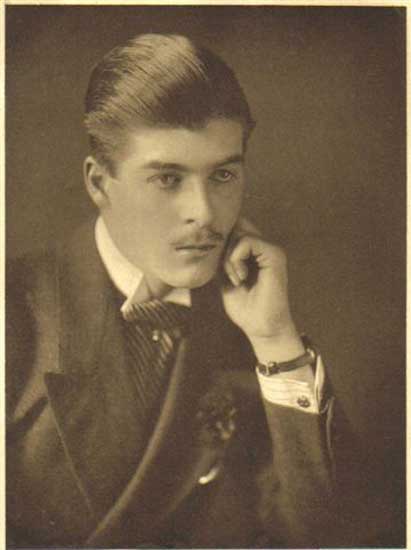
 Oscar Wilde's lover and a sonneteer. On his father's death, Tennant's mother married Lord Grey, a fellow bird-lover. Tennant's eldest brother was Edward – "Bim" – who was killed in the First World War.Lt. Edward Wyndham Tennant (1 July 1897 – 22 September 1916), was an English war poet, killed at the Battle of the Somme.
Oscar Wilde's lover and a sonneteer. On his father's death, Tennant's mother married Lord Grey, a fellow bird-lover. Tennant's eldest brother was Edward – "Bim" – who was killed in the First World War.Lt. Edward Wyndham Tennant (1 July 1897 – 22 September 1916), was an English war poet, killed at the Battle of the Somme.
.
He was educated at Winchester College, which he left aged 17. He joined the Grenadier Guards.

He was known to friends and family as Bim. It is unknown where this nickname derives from. It has been 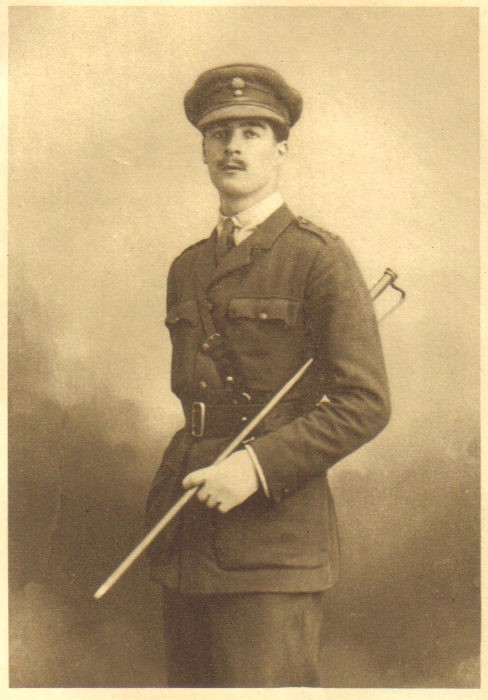 suggested that he was engaged at one point to Nancy Cunard.
suggested that he was engaged at one point to Nancy Cunard.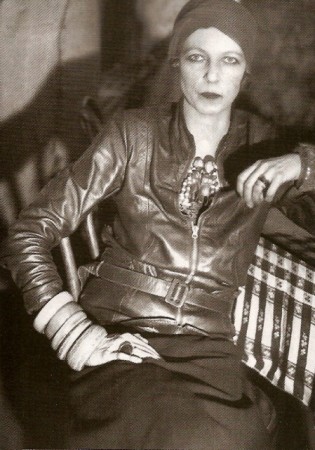 That this is untrue has been confirmed by two reliable sources: Colin Tennant, 3rd Baron Glenconner, who responded to this question by letter, and Lois Gordon, Nancy Cunard's biographer, who, in her extensive research, never came across any hint of such an alliance.
That this is untrue has been confirmed by two reliable sources: Colin Tennant, 3rd Baron Glenconner, who responded to this question by letter, and Lois Gordon, Nancy Cunard's biographer, who, in her extensive research, never came across any hint of such an alliance.
 suggested that he was engaged at one point to Nancy Cunard.
suggested that he was engaged at one point to Nancy Cunard. That this is untrue has been confirmed by two reliable sources: Colin Tennant, 3rd Baron Glenconner, who responded to this question by letter, and Lois Gordon, Nancy Cunard's biographer, who, in her extensive research, never came across any hint of such an alliance.
That this is untrue has been confirmed by two reliable sources: Colin Tennant, 3rd Baron Glenconner, who responded to this question by letter, and Lois Gordon, Nancy Cunard's biographer, who, in her extensive research, never came across any hint of such an alliance.Bim Tennant is buried in France at Guillemont Road Communal Cemetery close to his friend Raymond Asquith who was killed the week before.While leading the first half of 4 Company in an attack near Ginchy
close to his friend Raymond Asquith who was killed the week before.While leading the first half of 4 Company in an attack near Ginchy  on 15 September 1916, at the Battle of Flers-Courcelette,
on 15 September 1916, at the Battle of Flers-Courcelette, he was shot in the chest and died while being carried back to British lines. He was buried in Guillemont Road Cemetery, where his headstone is inscribed 'Small time but in that small most greatly lived this star of
he was shot in the chest and died while being carried back to British lines. He was buried in Guillemont Road Cemetery, where his headstone is inscribed 'Small time but in that small most greatly lived this star of 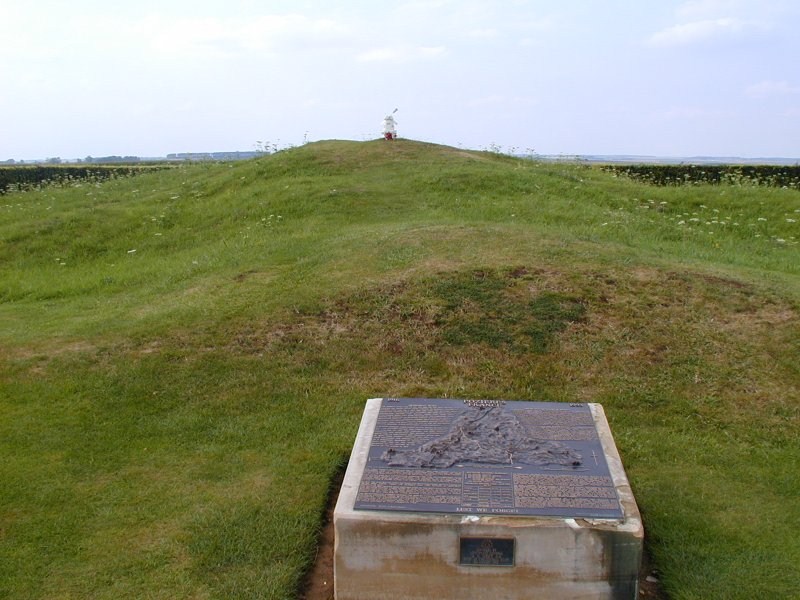 England',a concluding line from Shakespeare's "Henry V", about a warrior king who had died in his thirties after campaigns in France.
England',a concluding line from Shakespeare's "Henry V", about a warrior king who had died in his thirties after campaigns in France.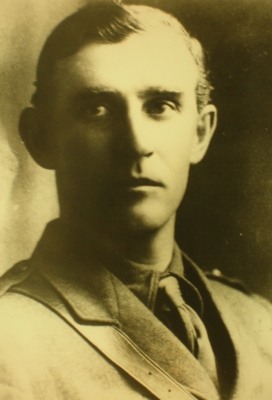
 on 15 September 1916, at the Battle of Flers-Courcelette,
on 15 September 1916, at the Battle of Flers-Courcelette, he was shot in the chest and died while being carried back to British lines. He was buried in Guillemont Road Cemetery, where his headstone is inscribed 'Small time but in that small most greatly lived this star of
he was shot in the chest and died while being carried back to British lines. He was buried in Guillemont Road Cemetery, where his headstone is inscribed 'Small time but in that small most greatly lived this star of  England',a concluding line from Shakespeare's "Henry V", about a warrior king who had died in his thirties after campaigns in France.
England',a concluding line from Shakespeare's "Henry V", about a warrior king who had died in his thirties after campaigns in France.
During the 20s and 30s, Stephen Tennant was an important member – the "Brightest", it is said – of the "Bright Young People." His friends included Rex Whistler, Cecil Beaton, the Sitwells, Lady Diana Manners and the Mitford girls – part of the set that made the Nordstrom Sisters popular at The Ritz in 1939. He is widely considered to be the model for Cedric Hampton in Nancy Mitford's novel Love in a Cold Climate; one of the inspirations for Lord Sebastian Flyte
He is widely considered to be the model for Cedric Hampton in Nancy Mitford's novel Love in a Cold Climate; one of the inspirations for Lord Sebastian Flyte in Waugh's Brideshead Revisited, and a model for Hon. Miles Malpractice in some of his other novels.For most of his life, Tennant tried to start or finish a novel – Lascar. It is popularly believed that he spent the last 17 years of his life in bed at his family manor at Wilsford, Wiltshire, which he had redecorated by Syrie Maugham
in Waugh's Brideshead Revisited, and a model for Hon. Miles Malpractice in some of his other novels.For most of his life, Tennant tried to start or finish a novel – Lascar. It is popularly believed that he spent the last 17 years of his life in bed at his family manor at Wilsford, Wiltshire, which he had redecorated by Syrie Maugham
 He is widely considered to be the model for Cedric Hampton in Nancy Mitford's novel Love in a Cold Climate; one of the inspirations for Lord Sebastian Flyte
He is widely considered to be the model for Cedric Hampton in Nancy Mitford's novel Love in a Cold Climate; one of the inspirations for Lord Sebastian Flyte in Waugh's Brideshead Revisited, and a model for Hon. Miles Malpractice in some of his other novels.For most of his life, Tennant tried to start or finish a novel – Lascar. It is popularly believed that he spent the last 17 years of his life in bed at his family manor at Wilsford, Wiltshire, which he had redecorated by Syrie Maugham
in Waugh's Brideshead Revisited, and a model for Hon. Miles Malpractice in some of his other novels.For most of his life, Tennant tried to start or finish a novel – Lascar. It is popularly believed that he spent the last 17 years of his life in bed at his family manor at Wilsford, Wiltshire, which he had redecorated by Syrie Maugham
.Syrie Wellcome and W. Somerset Maugham married in 1917 in New Jersey, although he was homosexual and would spend much of his marriage apart from his wife. They divorced in 1928. Her divorce settlement from Maugham was their house at 213 King's Road, fully furnished, a Rolls-Royce, and 2,400 pounds a year for her and 600 pounds a year for Liza.
fully furnished, a Rolls-Royce, and 2,400 pounds a year for her and 600 pounds a year for Liza.
 fully furnished, a Rolls-Royce, and 2,400 pounds a year for her and 600 pounds a year for Liza.
fully furnished, a Rolls-Royce, and 2,400 pounds a year for her and 600 pounds a year for Liza.Tennant, though undoubtedly idle, he was not truly lethargic: he made several visits to the United States and Italy, and struck up many new friendships, despite his later reputation as a recluse. This became increasingly true only towards the last years of his life. Yet even then, his life was not uneventful: he became landlord to V. S. Naipaul who immortalised Tennant in his novel The Enigma of Arrival. The paki said Do not write long sentences. A sentence should not have more than ten or twelve words.naipul says
Tennant in his novel The Enigma of Arrival. The paki said Do not write long sentences. A sentence should not have more than ten or twelve words.naipul says

2. Each sentence should make a clear statement. It should add to the statement that went before. A good paragraph is a series of clear, linked statements.
3. Do not use big words. If your computer tells you that your average word is more than five letters long, there is something wrong. The use of small words compels you to think about what you are writing. Even difficult ideas can be broken down into small words.

During the 1920s and 1930s, Tennant had a sexual affair with the poet Siegfried Sassoon. Sassoon's own depiction of the first night he spent with Tennant, whom the poet describes as "the most enchanting creature I have ever met". The two drove about 12 miles from a party at Tennant's Wiltshire house to Stonehenge, and stayed out until dawn, Tennant making "the most passionate avowals and simply intoxicating my senses"As the relationship develops, Sassoon describes taking another midnight stroll with Tennant, who wears only a silk dressing gown. Sassoon writes: "I can't control him (or myself) on such occasions." For his part, Tennant says that the famous poet often left him "swooning with happiness". One passage in his own journal reads: "He put his mouth over mine crushing it - some kisses seem to draw the very soul out of one's body - his do mine. I feel all my heart swooning at the touch of his mouth - my soul dies a hundred million deaths when his face is on my face and neck. "Sassoon was a man driven by his sexual passions.This has given us a far broader understanding of the man," he said. "He was obviously sexually repressed, which could well have helped drive him.
"Sassoon was a man driven by his sexual passions.This has given us a far broader understanding of the man," he said. "He was obviously sexually repressed, which could well have helped drive him. This gives further depth to our knowledge of him as an extremely complicated character, a recklessly brave officer, and a pacifist, torn between the worlds of the English gentry and the life he shared with his gay lover in London
This gives further depth to our knowledge of him as an extremely complicated character, a recklessly brave officer, and a pacifist, torn between the worlds of the English gentry and the life he shared with his gay lover in London
The passionate, fiery romance began after Sassoon and the outlandishly camp Tennant were introduced by mutual friends, and lasted from 1926 to 1932.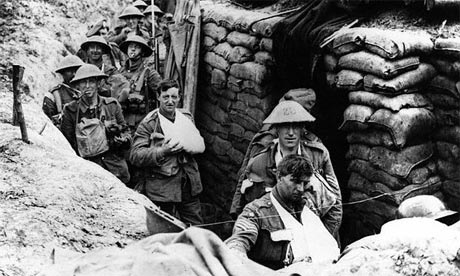 A year later, Sassoon married his wife Hester. Tennant was a glamourous figure, photographed by Cecil Beaton
A year later, Sassoon married his wife Hester. Tennant was a glamourous figure, photographed by Cecil Beaton and used as the model for Cedric Hampton by Nancy Mitford in her novel Love in a Cold Climate.
and used as the model for Cedric Hampton by Nancy Mitford in her novel Love in a Cold Climate. He later became a recluse and worked for 40 years on his novel Lascar.
He later became a recluse and worked for 40 years on his novel Lascar. His great-nephew, the playwright Simon Blow, said he was overjoyed that the contents of both diaries were finally become public knowledge. "I'm very glad that the record is being set straight, and I think this will be a very important biography," he said. "Some people have seen Uncle Stephen as a shallow person, but he wasn't at all. These diaries tell us so much more, and paint a far more detailed picture of this wonderful relationship between him and Siegfried.With the help of the poet's only son, George, Mr Egremont gained access to the Sassoon diaries, hitherto jealously guarded by the Sassoon estate. No biography of Sassoon appeareduntil the late 1990s, a fact bemoaned by scholars for decades
His great-nephew, the playwright Simon Blow, said he was overjoyed that the contents of both diaries were finally become public knowledge. "I'm very glad that the record is being set straight, and I think this will be a very important biography," he said. "Some people have seen Uncle Stephen as a shallow person, but he wasn't at all. These diaries tell us so much more, and paint a far more detailed picture of this wonderful relationship between him and Siegfried.With the help of the poet's only son, George, Mr Egremont gained access to the Sassoon diaries, hitherto jealously guarded by the Sassoon estate. No biography of Sassoon appeareduntil the late 1990s, a fact bemoaned by scholars for decades
 "Sassoon was a man driven by his sexual passions.This has given us a far broader understanding of the man," he said. "He was obviously sexually repressed, which could well have helped drive him.
"Sassoon was a man driven by his sexual passions.This has given us a far broader understanding of the man," he said. "He was obviously sexually repressed, which could well have helped drive him. This gives further depth to our knowledge of him as an extremely complicated character, a recklessly brave officer, and a pacifist, torn between the worlds of the English gentry and the life he shared with his gay lover in London
This gives further depth to our knowledge of him as an extremely complicated character, a recklessly brave officer, and a pacifist, torn between the worlds of the English gentry and the life he shared with his gay lover in London
The passionate, fiery romance began after Sassoon and the outlandishly camp Tennant were introduced by mutual friends, and lasted from 1926 to 1932.
 A year later, Sassoon married his wife Hester. Tennant was a glamourous figure, photographed by Cecil Beaton
A year later, Sassoon married his wife Hester. Tennant was a glamourous figure, photographed by Cecil Beaton and used as the model for Cedric Hampton by Nancy Mitford in her novel Love in a Cold Climate.
and used as the model for Cedric Hampton by Nancy Mitford in her novel Love in a Cold Climate. His great-nephew, the playwright Simon Blow, said he was overjoyed that the contents of both diaries were finally become public knowledge. "I'm very glad that the record is being set straight, and I think this will be a very important biography," he said. "Some people have seen Uncle Stephen as a shallow person, but he wasn't at all. These diaries tell us so much more, and paint a far more detailed picture of this wonderful relationship between him and Siegfried.With the help of the poet's only son, George, Mr Egremont gained access to the Sassoon diaries, hitherto jealously guarded by the Sassoon estate. No biography of Sassoon appeareduntil the late 1990s, a fact bemoaned by scholars for decades
His great-nephew, the playwright Simon Blow, said he was overjoyed that the contents of both diaries were finally become public knowledge. "I'm very glad that the record is being set straight, and I think this will be a very important biography," he said. "Some people have seen Uncle Stephen as a shallow person, but he wasn't at all. These diaries tell us so much more, and paint a far more detailed picture of this wonderful relationship between him and Siegfried.With the help of the poet's only son, George, Mr Egremont gained access to the Sassoon diaries, hitherto jealously guarded by the Sassoon estate. No biography of Sassoon appeareduntil the late 1990s, a fact bemoaned by scholars for decadesPeter Parker said the decision of Sassoon's son to release the diaries was "immensely brave", given the graphic detail. "Quite a lot of what is revealed is very explicit. Here is a man with a complicated homosexual private life," he said. "It is one thing to release that if you are talking about a distant relative, but quite another if it is your own fathe
Prior to this he had proposed to a friend, Elizabeth Lowndes, but had been rejected. (Hoare relates how Tennant discussed plans with Lowndes about bringing his Nanny with them on their honeymoon.)
but had been rejected. (Hoare relates how Tennant discussed plans with Lowndes about bringing his Nanny with them on their honeymoon.) His relationship with Sassoon, however, was to be his most important: it lasted some four years before Tennant off-handedly put an abrupt end to it. Sassoon was reportedly depressed afterwards for three months, until Sassoon married in 1933 and became a father in 1936. When Tennant died in 1987, he had far outlived most of his contemporaries.The Tennants were farmers living a basic existence in Ayrshire. Their farm was called Glenconner (after which great-grandfather Eddy was to take his title).
His relationship with Sassoon, however, was to be his most important: it lasted some four years before Tennant off-handedly put an abrupt end to it. Sassoon was reportedly depressed afterwards for three months, until Sassoon married in 1933 and became a father in 1936. When Tennant died in 1987, he had far outlived most of his contemporaries.The Tennants were farmers living a basic existence in Ayrshire. Their farm was called Glenconner (after which great-grandfather Eddy was to take his title).
 but had been rejected. (Hoare relates how Tennant discussed plans with Lowndes about bringing his Nanny with them on their honeymoon.)
but had been rejected. (Hoare relates how Tennant discussed plans with Lowndes about bringing his Nanny with them on their honeymoon.) His relationship with Sassoon, however, was to be his most important: it lasted some four years before Tennant off-handedly put an abrupt end to it. Sassoon was reportedly depressed afterwards for three months, until Sassoon married in 1933 and became a father in 1936. When Tennant died in 1987, he had far outlived most of his contemporaries.The Tennants were farmers living a basic existence in Ayrshire. Their farm was called Glenconner (after which great-grandfather Eddy was to take his title).
His relationship with Sassoon, however, was to be his most important: it lasted some four years before Tennant off-handedly put an abrupt end to it. Sassoon was reportedly depressed afterwards for three months, until Sassoon married in 1933 and became a father in 1936. When Tennant died in 1987, he had far outlived most of his contemporaries.The Tennants were farmers living a basic existence in Ayrshire. Their farm was called Glenconner (after which great-grandfather Eddy was to take his title).
The Tennant patriarch was nicknamed 'Auld Glen'. he spawned a number of children. he was a friend of Robert Burns who wrote a poem about the Ayrshire Tennants.
Burns was aware of Auld Glen's ninth child, the one he dubbed 'wabster Charlie' - wabster means weaver.
For this Charles Tennant apprenticed himself to a weaver, but all the time he was working on a chemical solution to make bleach. With perseverance he got there.
Mankind had been bleaching fabrics for centuries, ever since the ancient Greeks and Romans, who used soda ash made from burned seaweed to clean and whiten cloth.
Before Charles's invention, fabrics were spread out in large fields for maximum sunlight exposure; they were washed and washed and treated with various chemicals and spread out again in the bleaching fields.
But this method was lengthy and tedious, and took over large tracts of land that could have been used for farming. When he made his breakthrough, it revolutionised the textile industry. he built his factory in an area of glasgow.Siegfried Sassoon bought Heytesbury House in 1933, with money left by a rich aunt, and he used the cricket ground to find solace in the sport of his youth.
Sassoon was the bravest of cricketers on two counts, and possibly three.
First came his physical, military bravery, when he led his men over the top several times in the First World War, including at the Somme, armed only with a pistol, and was awarded the Military Cross in 1916 “for conspicuous gallantry”.
But a few other cricketers have matched such bravery. Like Douglas Bader, who played a first-class game for the Royal Air Force in 1931 just before he lost both legs in a flying accideWhat sets Sassoon apart is that he risked being shot when on leave from the trenches as well.
His statement of protest against the mad futility of the First World War was read out in the House of Commons by an MP. Pacifists such as Bertrand Russell had protested against the war, but not somebody who had been there and done that.
Even the madness of the Lord Melchetts could not have a man with an MC court-martialled and shot for cowardice.
So Sassoon was sent to Craiglockhart hospital, where he protested even more eloquently in his war poems, inspired by the company of Wilfred Owen.
Soldiers are dreamers; when the guns begin
They think of firelit homes, clean beds and wives.
I see them in foul dug-outs, gnawed by rats,
And in the ruined trenches lashed with rain,
Dreaming of things they did with balls and bats.
They think of firelit homes, clean beds and wives.
I see them in foul dug-outs, gnawed by rats,
And in the ruined trenches lashed with rain,
Dreaming of things they did with balls and bats.
In a third way, too, Sassoon may have been the bravest of all cricketers.
When he played for Heytesbury – as a defensive batsman, intent on survival – he fielded at mid-on in a unique manner.
Last week I visited Dennis Silk near Taunton. Before becoming the warden of Radley and chairman of the Test and County Cricket Board, Silk played alongside Sassoon at Heytesbury.
Unlike Sassoon’s three previous biographers, Silk knew him well — received over 80 letters from him — and his biography is due out later this year in the War Poets series.
Imitating Sassoon at mid-on, Silk stood almost to attention, folded his arms, then bent his knees slightly.
Sassoon, without shin-pads, would simply let the ball hit him, however hard it was driven, then amble to pick up the ricochet. “We all turned to jellies,” Silk recalled of his teammates’ mirth.
Now it’s very tempting for a tall and ageing fielder not to bend (believe me). But here is a strange thing: Sassoon was double-jointed, and Silk recalls him, even in his dotage, bending down to tie his shoelaces without needing to bend his knees.
So Sassoon could have bent down and got his hands to the ball when driven along the ground. But he didn’t. And why not?
“He was still having terrible nightmares in 1953 when I first him,” Silk said.
Sassoon’s most terrible memory was of looking at his watch as the last seconds ticked before the signal to go over the top, and knowing that in a few minutes most of his men would not exist.
Survivors of the First World War, we know, were plagued with guilt.
Could it be that Sassoon — who eventually converted to Catholicism, after his cricket playing — was doing some form of penance by letting the ball hit his unprotected legs?
Painful to anyone else, but small beer compared to the two bullets a sniper had fired into his neck, and all the suffering that Sassoon had seen.
No comments:
Post a Comment